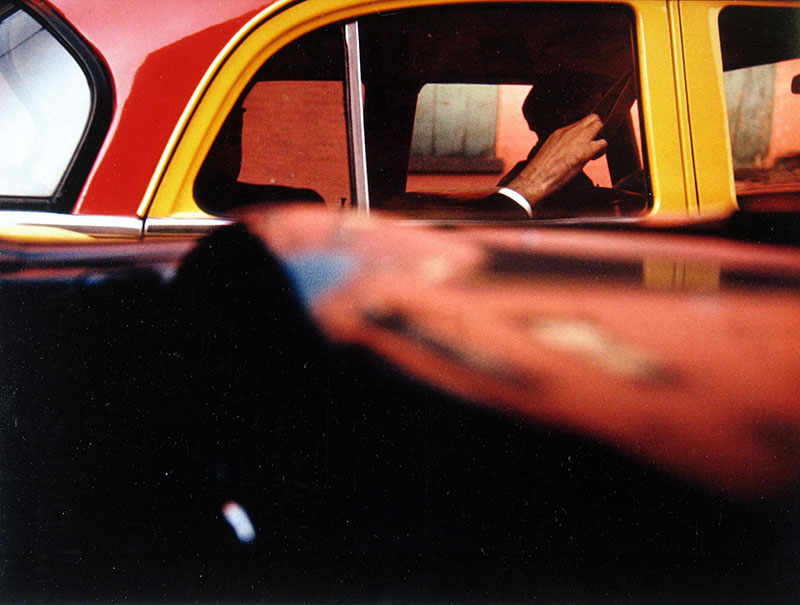
Saul Leiter Taxi c1957
When I read that Angela Merkel visited Auschwitz this week (for the first time ever, curiously, after 14 years as Chancellor, and now it’s important?), my first thought was: she should have visited Julian Assange instead. I don’t even know why, it just popped into my head. And then reflecting on it afterwards, of course first I wondered if it’s acceptable to compare nazi victims to Assange in any way, shape or form.
There are many paths to argue it is not. He is not persecuted solely for being part of a group of people (we can’t really use “race” here). There are not millions like him who are being tortured and persecuted for the same reasons he is. There is no grand scheme to take out all like him. There is no major police or army force to execute any such scheme. These things are all obvious.
But I grew up in Holland, where unlike in Merkel’s Germany, the aftermath of WWII and the Holocaust was very much present. I looked it up, and it’s already almost 10 years ago that I wrote Miep Gies Died Today, in which I explained this. Miep Gies was a woman who worked for Anne Frank’s father Otto, helped hide the family in the annex, and after the war secured Anne’s diary (or we would never have known about it) and handed it to Otto Frank.
So accusing me of anti-semitism for comparing the Holocaust to what is being done to Assange is not going to work. Why then did Merkel never visit Auschwitz before this week, and when she did, said how important it is to German history? And why did she not visit Assange instead?
Unlike the people who died in Auschwitz and other concentration camps (Anne Frank died in Bergen Belsen from typhoid), Julian Assange today, as we speak, IS being persecuted, he IS being tortured, and he IS likely to die in a prison. What does Angela Merkel think that Anne Frank would have thought about that? Would she have written in her diary that it was okay?
Would all those millions of Jewish and Roma and gay victims have thought that? There are 75+ years that have gone by. We can not get these victims back, we can not magically revive them. But we CAN make sure that what happened to them, torture and murder, doesn’t happen to people today. “Never Again”, right? Well, it IS happening again.
Are we all supposed to go say “I didn’t know” -“Ich hab es nicht gewüsst”- like the Germans did, and all those who collaborated with them across Europe?
There are victims who are dead, and there are victims who are -barely- alive. And if you claim you wish to honor the dead victims, you must ask what they would have felt about the ones like them who are still alive. Otherwise, you’re not honoring them, you’re just posing and acting and, in the end, grossly insulting them.
Julian Assange is not in a German prison, true, but Angela Merkel is still the uncrowned queen of Europe, and if she would visit Julian in his Belmarsh torture chamber it would make a huge difference. That she elects to visit Auschwitz instead, does not only make her appear hollow and empty, it is a grave insult to the likes of Anne Frank and all the other nazi victims.

Which brings me to another Assange-related issue. The Guardian’s editor, Katharine Viner, launched an appeal yesterday for people to donate money to her paper’s “climate emergency” fund. That in itself is fine. If people think they need to help save the planet with their savings, sure.
Though I will always have suspicions about all these things. From where I stand, I see too many people claiming to save the planet, oil CEOs and billionaires first, and too much money being invited to join their funds. If you want to donate something for the cause, why do it via a newspaper? But even with that in mind, yeah, whatever, it’s Christmas time. Who cares how effective the money will be?
My problem with Katharine Viner and the Guardian is that they have played a very active role in the smearing and persecution of Julian Assange. They’ve published articles that were proven to be 100% false, and never retracted them, or apologized, or attempted to make things right. The Guardian is a major reason why Julian is where he is. It has accommodated, make that encouraged, the British people’s “Ich hab es nicht gewüsst”.
You can donate to the Guardian’s climate emergency fund, if you believe they don’t run it to make you think they really care about the planet more than about their bottom line, but be careful: you will also be supporting the further smearing and persecution of Julian Assange. Are you sure you want to do that?
See, the headline for Katharine Viner’s article is: The Climate Crisis Is The Most Urgent Threat Of Our Time. And it’s not. The most urgent threat is that to Julian Assange’s health. That is today, not in 5 or 10 or 100 years. After all, what is the use of saving the planet if we allow the smartest and bravest among us to be tortured to death? What do we think Anne Frank would have said about that?

Include the Automatic Earth in your Christmas charity list. Support us on Paypal and Patreon. We need you.
Top of the page, left and right sidebars. Thank you.








